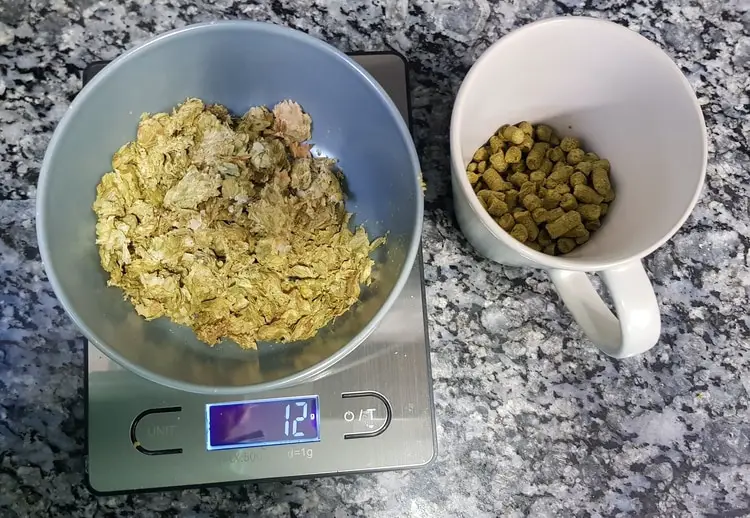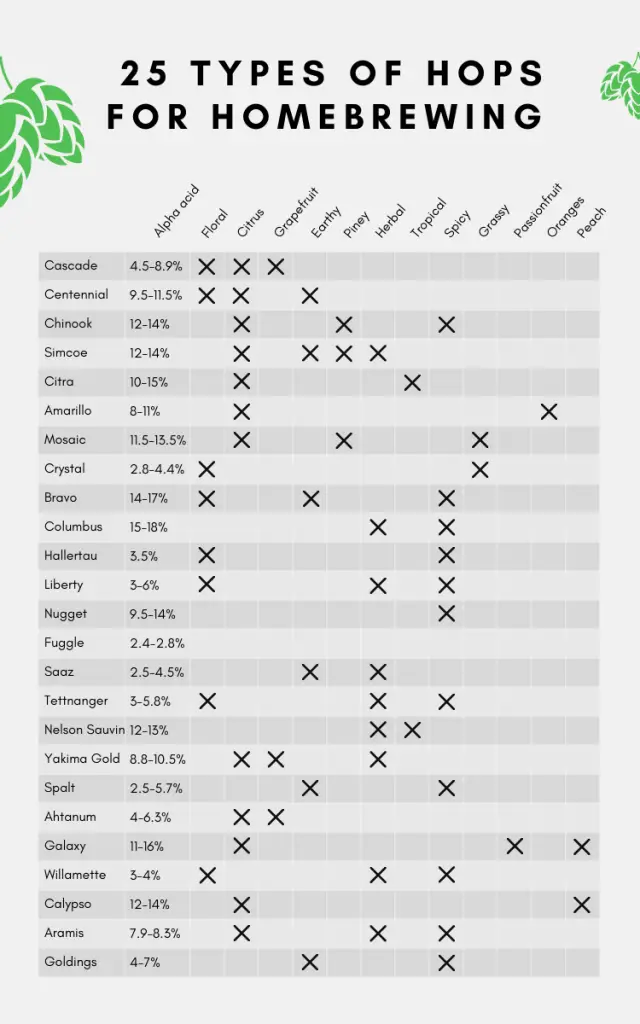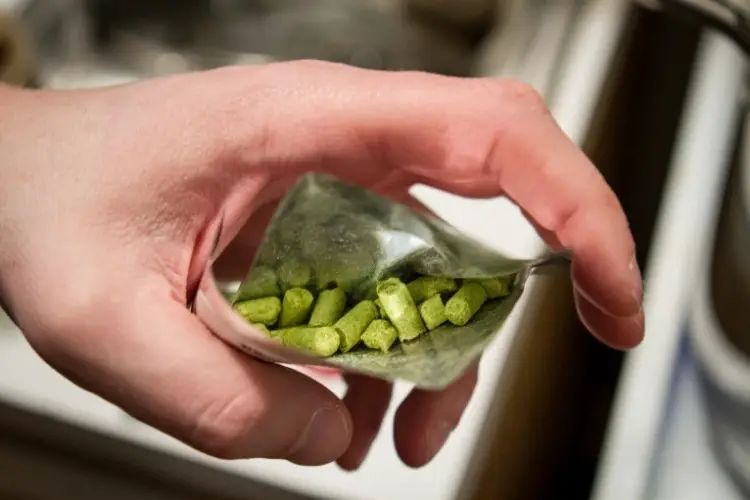Today there are more hops than ever. From classic Old World hops that have been around for ages to new hops being released every other month. The noble Humulus lupulus plant and its fragrant flower cones are perhaps beer’s most important ingredients.
Choosing the right hop for your brewing undertaking is no easy feat.
Either you follow a trialed and tested recipe, or you go at it by heart.

There’s lots of experimentation involved, and not all hops will take your beer in the direction you want.
The good news is that hops alone will rarely ruin your beer. You might stray away from your desired beer style, but then again, you might just come up with something entirely new and exciting.
To help you make the right choice, here are 25 different types of hops and their beer-making profile.

1. Cascade
Origin: USA
Alpha acid: 4.5-8.9%
Used for its bitterness: Yes
Used for aromas: Yes
Flavor profile: floral, citrus, grapefruit
Often used in: Barley Wine, American Pale, Ale, Lager
Cascade was developed by the Oregon State University in the 60s and is one of the most used hops in the US. Easy to grow and with very appealing aromatics. This one is a favorite for light beers.
2. Centennial
Origin: USA
Alpha acid: 9.5-11.5%
Used for its bitterness: Yes
Used for aromas: Yes
Flavor profile: citrus, floral, earthy
Often used in: British Bitter, Barley Wine, IPA, Pale Ale
Bred in the 70s, this hop is quite aromatic. Sometimes known as ‘super cascade’, this varietal is widely prized for bold styles like IPAs.
3. Chinook
Origin: USA
Alpha acid: 12-14%
Used for its bitterness: Yes
Used for aromas: Yes
Flavor profile: citrus, spice, piney
Often used in: IPA, Porter, Stout, American Ale, American Lager
With high alpha and beta acids, this hop can do it all, and it’s spicy and piney aromas are behind its popularity. Bred in the 80s in Washington state, this is one of the most used hops in the US.
4. Simcoe
Origin: USA
Alpha acid: 12-14%
Used for its bitterness: Yes
Used for aromas: Yes
Flavor profile: earthy, piney, herbal, citrus
Often used in: Pale Ale, IPAs, Double IPAs
Bred in the 00s, Simcoe YCRrv is versatile and intensely aromatic. It’s extensively used both commercially and by home brewers for its noble character and stratified aromas.
5. Citra
Origin: USA
Alpha acid: 10-15%
Used for its bitterness: Yes
Used for aromas: Yes
Flavor profile: citrus, tropical, bitter
Often used in: IPA, American Ales, Amber styles
Citra was bred by the Hop Breeding Company in the US and was relatively recently released in 2007. It became immediately popular for its bright aromatics and high alpha acids. Quite tropical, it’s used in almost all successful IPAs.
6. Amarillo
Origin: USA
Alpha acid: 8-11%
Used for its bitterness: No
Used for aromas: Yes
Flavor profile: citrus, oranges
Often used in: American Pale Ale, IPA, American What, Bitter, ESB
Discovered growing wild late in the 20th-century, Amarillo VGXP01cv is a popular aromatic hop with middle-range alpha acids.
7. Mosaic
Origin: USA
Alpha acid: 11.5-13.5%
Used for its bitterness: Yes
Used for aromas: Yes
Flavor profile: citrus, grassy, piney
Often used in: IPA, Pale Ale
Mosaic HBC369cv is a Nugget derivate with high alpha acids and astounding versatility. Tropical and earthy, these hops give distinct profiles to fruit-forward beers.
8. Crystal
Origin: USA
Alpha acid: 2.8-4.4%
Used for its bitterness: No
Used for aromas: Yes
Flavor profile: floral, woody, spicy
Often used in: American Lager, Bitter, Pilsner, Pale Ale, IPA, Chocolate Stout
Developed in the early 90s, this Hallertau-Cascade derivative hop is relatively mild in alpha acids and is lovely on European-style beers.
9. Bravo
Origin: USA
Alpha acid: 14-17%
Used for its bitterness: Yes
Used for aromas: No
Flavor profile: earthy, spicy, floral
Often used in: American Pale Ale, IPA, ESB
This super-high alpha hop bred by the Hopsteiner team in 2006 is provocative and bold, ideal for new world hoppy beers with fruit-forward character.
10. Columbus/Tomahawk/CTZ
Origin: USA
Alpha acid: 15-18%
Used for its bitterness: Yes
Used for aromas: Yes
Flavor profile: spicy, herbal
Often used in: Barley Wine, Imperial Stout, American Ales, Stout, Imperial Brown Ale
Known as Tomahawk, Columbus or Zeus, this ultra-high alpha hop is part of the famous ‘Three Cs’ along with Cascade and Centennial. Very versatile and bold.
11. Hallertau
Origin: Germany
Alpha acid: 3.5%
Used for its bitterness: No
Used for aromas: Yes
Flavor profile: flowery, spicy
Often used in: Pilsner, Pale Ale, Wheat, American Lager
One of the original German noble hops, this mild varietal, is grown in Bavaria. Floral and spicy, this hop is behind some of the most classic beer profiles on the planet.
12. Liberty
Origin: USA
Alpha acid: 3-6%
Used for its bitterness: No
Used for aromas: Yes
Flavor profile: herbal, floral, spicy
Often used in: Lager, Pale Ale, Bock
Bred in the early 80s, this American-German cross is similar to the noble German Hallertau hop. Ideal for old-world-inspired beers.
13. Nugget
Origin: USA
Alpha acid: 9.5-14%
Used for its bitterness: Yes
Used for aromas: Yes
Flavor profile: fruity, resinous, spicy
Often used in: IPA, Imperial IPA
One of the first super-alpha hops, Nugget was bred in the 70s in Oregon. It changed the world or hops in the eighties but has lost popularity to more modern varietals.
14. Fuggle
Origin: UK
Alpha acid: 2.4-2.8%
Used for its bitterness: No
Used for aromas: Yes
Flavor profile: hoppy, mild
Often used in: English Ale, ESB, Lambic, Oatmeal Stout, Strong Ale, Brown Ale
A classic British hop known as the Styrian Golding. Most modern hops, including the Centennial and Cascade, come from this noble hop. This hop grew wild, as far back as the middle 1800s.
15. Saaz
Origin: Czech Republic
Alpha acid: 2.5-4.5%
Used for its bitterness: No
Used for aromas: Yes
Flavor profile: noble, herbal, earthy
Often used in: Lager, Pilsner
This Czech hop is responsible for the famous Pilsners, some of the first fresh and clear beers in existence. Named for the city of Saaz, this is a quintessential hop for crisp lagers and European blond ales.
16. Tettnanger
Origin: Germany
Alpha acid: 3-5.8%
Used for its bitterness: Yes
Used for aromas: Yes
Flavor profile: herbal, floral, spicy
Often used in: Blond Ales, Pilsner, Lager, Amber, Hefeweizen, Wheat beer
A noble dual-purpose German hop coming from the town of Tettnang. The varietal adds delicate, layered aromas reminiscent of classic European beers.
17. Nelson Sauvin
Origin: New Zealand
Alpha acid: 12-13%
Used for its bitterness: Yes
Used for aromas: Yes
Flavor profile: herbal, tropical, fruity
Often used in: IPA, Pale Ale
Developed in the late 80s but popularized in the early 00s, this homage to New Zealand’s flagship wine grape Sauvignon Blanc has fruity aromas reminiscent of gooseberries, and it’s said to add vinous flavors to the beer.
18. Yakima Gold
Origin: USA
Alpha acid: 8.8-10.5%
Used for its bitterness: Yes
Used for aromas: Yes
Flavor profile: grapefruit, lemon zest, herbal
Often used in: Dark Ales, IPA, Lagers
A recent varietal by Washington State University. Yakima Gold was released in 2013, and it’s versatility as an aromatizing and bittering agent has gained popularity. It is said to resemble noble European hops such as the Saaz.
19. Spalt
Origin: Germany
Alpha acid: 2.5-5.7%
Used for its bitterness: No
Used for aromas: Yes
Flavor profile: spicy, earthy
Often used in: Pilsner, Bock, Kolsch, German Ales
Woody and earthy, this varietal is part of Germany’s noble hops. It is grown near the Spalter region and is priced for its mild and balanced aromatics.
20. Ahtanum
Origin: USA
Alpha acid: 4-6.3%
Used for its bitterness: No
Used for aromas: Yes
Flavor profile: citrus, grapefruit
Often used in: IPA, Pale Ale, American Ales, Lagers, Hefeweizen
Ahtanum YCR1cv is an aromatic hop with layered scents and a refined quality. Some brewers describe it as a toned-down version of the Cascade hop.
21. Galaxy
Origin: Australia
Alpha acid: 11-16%
Used for its bitterness: Yes
Used for aromas: Yes
Flavor profile: citrus, passionfruit, peach
Often used in: ESB, IPA, Pale Ale
Perhaps the most popular Australian hop, Galaxy is prized for its fruit-forward character. Bred in 1994, it has gained recognition worldwide for its tropical fruit aromas and duel-purpose versatility.
22. Willamette
Origin: USA
Alpha acid: 3-4%
Used for its bitterness: No
Used for aromas: Yes
Flavor profile: herbaceous, floral, spicy
Often used in: Porter, American Ale, Brown Ale, English Ale
Bred in 1976, this popular hop comes from the English Fuggle hop, but it’s more fruit-forward. Very similar to the Ahtanum.
23. Calypso
Origin: USA
Alpha acid: 12-14%
Used for its bitterness: Yes
Used for aromas: Yes
Flavor profile: stone fruits, citrus
Often used in: Stout, Ales, Barley Wine
Bred in the Yakima Valley, this aromatically focused hop is prized for its high alpha levels and stone fruit profile. A very complex dual-purpose hop.
24. Aramis
Origin: France
Alpha acid: 7.9-8.3%
Used for its bitterness: No
Used for aromas: Yes
Flavor profile: spice, citrus, herbs
Often used in: Lager, Pilsner, Wheat, IPA, Pale Ale, Porter, Saison
This popular French hop is a cross between Golding and Strisselspalt. It’s grown in Alsace, it has a noble feel, and it’s incredibly reliable.
25. Goldings
Origin: Canada
Alpha acid: 4-7%
Used for its bitterness: No
Used for aromas: Yes
Flavor profile: earthy, spicy
Often used in: Porter, Stout English Pale Ale
Originally from the UK, this hop yields significant results in Canada’s British Columbia. There are several types of Goldings, and they go back to the 1750s. It’s widely used in dark beers with roasted malts.

